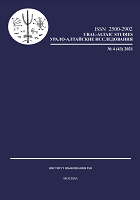МОНГОЛЬСКИЕ ЭЛЕМЕНТЫ В ЭТНОНИМИКЕ И ЭТНОТОПОНИМАХ ДОЛИНЫ ЗЕРАВШАНА (XV – XIX вв.)
MONGOLIAN ELEMENTS IN THE ETHNONYMY AND ETHNOTOPONYMS OF THE ZERAVSHAN VALLEY (15-19th CENTURIES)
Author(s): Azim MalikovSubject(s): Archaeology, Regional Geography, Ethnohistory, 15th Century, 19th Century, Migration Studies
Published by: Институт языкознания Российской академии наук
Keywords: Mongols; Kalmaks; Chagatai; Samarkand; Bukhara; ethnonyms; toponyms;
Summary/Abstract: This article, based on written sources and archival materials, analyzes the role of Mongolian components in the formation of tribal names and ethnotoponyms of the Zerafshan Valley from the 15th to the 19th centuries. The research revealed the dynamics of penetration and distribution of Mongolian ethnonyms at different levels of the tribal organization of Turkic-speaking tribes of the region. Numerous migrations of Turkic-Mongolian clans to the Zerafshan valley covered a long period, starting from the campaigns of Genghis Khan until the middle of the 18th century. In the region, at different times, the perception of the boundaries of the Mongol community changed. If in the 13th - early 14th centuries under the name Mongol an ethnopolitical community was understood, as well as the inhabitants of the Mogholistan region, then later it designated the tribe and clan as part of individual tribes. If in the first waves of migration of Mongolian tribes to the oases of Central Asia their composition could include the main Mongolian clans, then in the following centuries their Turkification took place in the steppe regions and already Turkified tribes or alliances of tribes containing Turkic clans invaded and settled into the valleys. As a result of the migrations of the nomadic population groups from the steppe regions to the Zerafshan valley, the tribal composition of the population became enriched and the number of Mongolian names, which were perceived by the local population as Turkic, Uzbek, Kazakh and Karakalpak ethnonyms, increased. Many Mongolian elements were included in the toponymy not by the Mongols themselves, but by Turkic or Turkified tribes. The total number of Mongolian elements in the ethnotoponymy of the Zerafshan Valley rose due to the settlement of semi-nomadic clans in the 18th - early 19th centuries. They became more widespread in the Samarkand and Navoi provinces and less common in the Bukhara oasis
Journal: Урало-алтайские исследования
- Issue Year: 2021
- Issue No: 04 (43)
- Page Range: 84-105
- Page Count: 22
- Language: Russian

